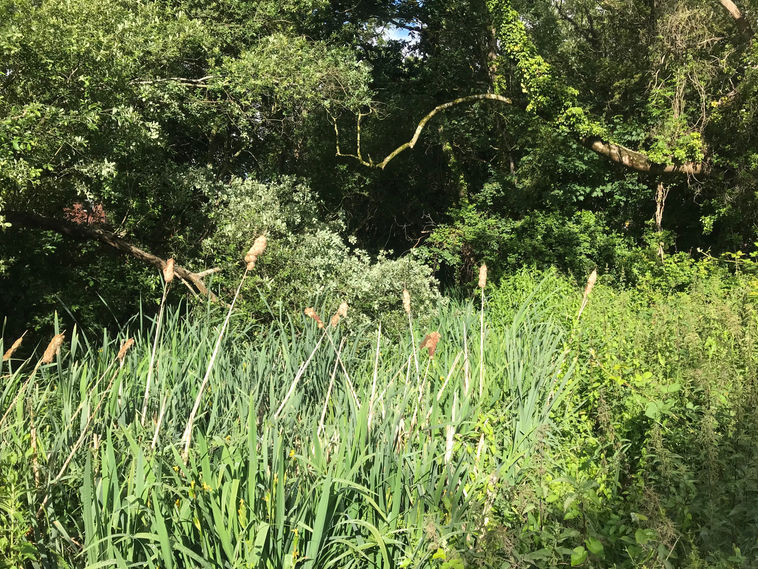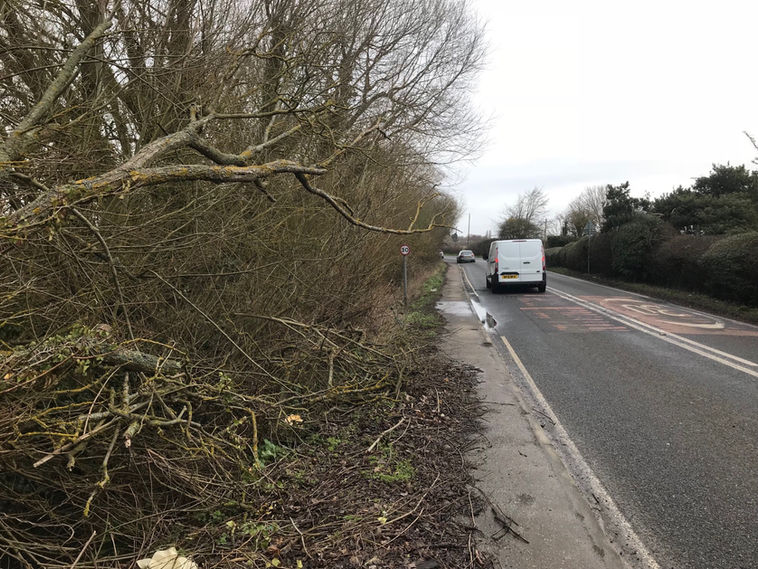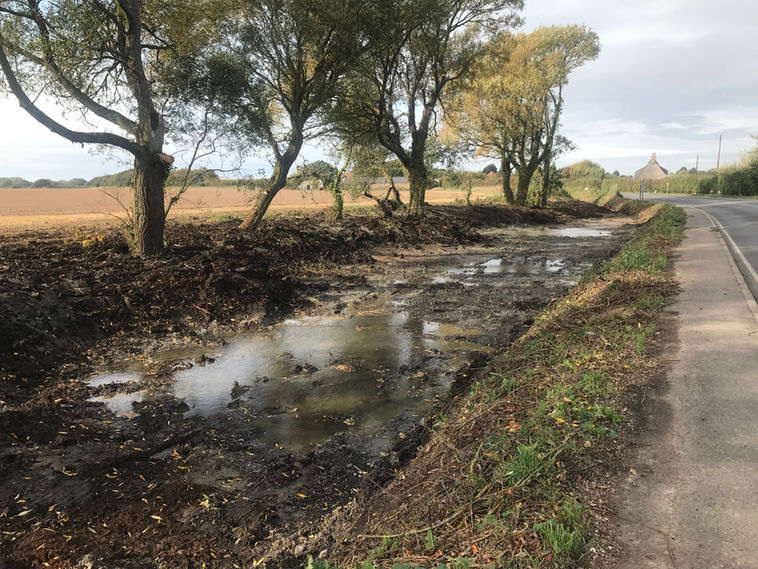The Fixing and Linking Our Wetlands (FLOW) Project has been funded to restore wetland across the Manhood Peninsula, to secure vital habitat for wildlife and improve local flood management. This conservation work is powered by a dedicated team and active volunteers, trained in natural heritage skills.
AIMS
To prevent flooding and protect wildlife, through the restoration and reconnection of wetland features. To encourage local parishes to care for their environment and train individuals in natural flood management techniques.
BACKGROUND

Wetland features, such as ditches, mudflats, ponds and streams, bring many benefits to people and wildlife. Wetlands naturally clear our drinking water of pollutants and provide a vital source of food and shelter to 70% of the planet’s wildlife species. Well managed wetlands also absorb excess rainfall and allow water to flow freely out to sea, which safeguards communities against flooding events.
The wetland network on the Manhood Peninsula is particularly important as it connects three protected areas; Pagham Harbour, Medmerry Nature Reserve, and Chichester Harbour. Without safe and connected waterways, wetland species can become isolated and suffer population decline from a lack of breeding opportunities and subsequent loss of genetic diversity.

Water vole numbers in the UK are declining rapidly due to loss of suitable and connected wetland habitats.
In 2015, the National Lottery Heritage Fund funded a pilot phase of the FLOW project, which completed a condition assessment of ditches in West Wittering and produced of a map of the parish’s wetland features. A wetland management plan was created from this data and a further five-years of funding were granted to the project, to implement the plan across the whole peninsula.
METHODS
The project is led by Jane Reeve and also employs a team who lead practical fieldwork and highlight the importance of wetlands, through local events and online engagement. An active volunteer group regularly help the FLOW team carry out surveys and restoration work.

Surveying

Tree Planting
.jpg)
Landscaping
Wildlife and Habitat Surveying
A healthy inland wetland habitat has surrounding hedgerows and tree cover, direct access to sunlight, free flowing drainage, and attracts a variety of wildlife species. Sites are surveyed for these features to inform an individualised restoration plan. These surveys are repeated annually to monitor improvements in flood water management and wildlife activity.
Bat, moth, and water vole population numbers are of particular interest, as their presence indicates the habitat is well connected and thriving. Signs of invasive American Mink are monitored and sightings are uploaded to the national Biological Record’s Centre database, via the iRecord website. The mink population is strictly controlled in the UK, to protect water voles and ground nesting sea birds from predation.
_.jpg)
American Mink (Neovison vison)
Restoration Work
Key aspects of the restoration process include filling in sparse hedgerows, planting native trees, and stabilizing banks with the addition of riparian plants. This improves the habitat as a whole and increases safe travel routes for wildlife, along the waterways.
Debris and vegetation, which obstruct water flow, are removed from ditches to prevent stagnant water and nearby surface flooding. Ponds with poor water holding potential are excavated with diggers by external contractors, to increase their capacity.
If a watercourse is too overshadowed by previously unmanaged trees, these trees are trimmed back or cut down to the ground (coppiced) to bring much needed sunlight to the oxygenating plants that live in the water. Coppiced wood is stacked on site to create ‘dead hedge’ habitats for insects.

Education and Training
Volunteers are trained in traditional skills of coppicing and hedge laying, as well as other landscaping, planting, surveying, GIS mapping, and wildlife identification techniques.
Engaging with the community through schools, local events, and online campaigns, allows the project to increase awareness of the importance of wetland habitats. The team also work closely with landowners and produce information guides to make wetland management skills accessible to everyone.
The FLOW Project has created an in depth template for carrying out wetland management projects. This template includes recommended steps for pre-work data gathering, improvement work and ongoing post work management. Specific advice for improving habitats for water voles, is also detailed in this guide.
View the FLOW method for wetland habitat improvement.
RESULTS

To date, 50 wetland sites have been restored in West Wittering, Apuldram, Donnington, Earnley, East Wittering & Bracklesham, Hunston, North Mundham, Selsey, Sidlesham, West Itchenor and Birdham, and over 10,000 trees have been planted in these parishes.
In 25% of sites that previously had no water voles, their presence was noted within 12 months of restoration work starting and an increase in sightings of kingfishers and bat species, have also been recorded. These positive results are expected to increase as the habitats naturally develop over time.
Download the FLOW Wetlands Trail Guide to discover the beautiful sites restored throughout the project.
The guide is divided into nine out of the eleven parishes on the Manhood Peninsula. Each parish has a map showing the site locations, and some parishes have a short walking route option, giving you an exciting opportunity to encounter other fascinating local heritage features along the way. Just look out for the footprints...
Extensive reports have been made to document the progress achieved in each parish.
Over 150km of ditches and 30km of hedgerow have been surveyed over the course of the project and this data has been used to create up to date GIS maps of the peninsula’s wetland features, to support their ongoing protection and management.
(Click the map to view a full screen version and download a PDF version)
Click images for full screen view:
"The FLOW project has been successful, achieving, and regularly exceeding, its desired outputs and outcomes and having a real impact on the heritage, people, and communities of the Manhood Peninsula."
Read the full independent evaluation report, produced by Resources for Change, which analyses the FLOW Project's overall performance.
PARTNERSHIPS & FUNDING
FUNDING
National Lottery Heritage Fund
The five year project is funded by a grant from the National Lottery Heritage Fund.
Manhood Wildlife and Heritage Group (MWHG)
Funded by your donations, distributed through MWHG.
The restoration of the relic canal in North Mundham, was part-funded by the New Homes Bonus Fund. A Service Level Agreement with CDC supports FLOW’s work.
CDC has also provided O/S base maps for GIS use, and host our annual evaluation meetings within their offices.
The Operation Watershed scheme has funded restoration work at the Willow Glen site, a tools container, and tools for other habitat improvement.
WSCC has also printed maps for the team, and granted access to parish council GIS layers. and granted access to parish council GIS layers.
Funded species surveying equipment, through the
Local Community Projects Fund.
Donations received through the Community Matters Fund have provided equipment and gloves.
Contributed to the Willow Glen area improvement work and funded two interpretation boards.
Funded the management of Kingfisher Village Pond and two interpretation boards.
Granted funds for the creation of a dead hedge habitat, other ditch habitat improvement work, and contributed towards one interpretation board.
The Council has also provided event space at Bracklesham Barn.
Funded an interpretation board for the estate.
West Wittering Estate also provided a tree surgeon to support a day’s work.
Contributed towards the map creation for the Neighbourhood Plan.
Contributed towards an interpretation board and the map creation for the Neighbourhood Plan.
The Tree Planting Grant contributed to the planting of trees across the area to mitigate climate change.
Part-funded the North Mundham relic canal restoration work.
Contributed towards an interpretation board.
Contributed to digging work at the Sparrow Cottage site and towards one interpretation board.
SUPPORTERS
Provided use of the Selsey Centre for wetland management workshops and parish results events.
West Itchenor Park Farm
Staff carried out three days of chainsaw work for the project.
Distributed 1850 trees, hedge plants and rabbit guards to FLOW, from the Woodland Trust.
Distributed 3800 native trees to the project, from OVO Energy.
Local community
Locals carried out chainsaw work, and provided native wetland plants, bulbs and rabbit guards.
Landowners
Provided assistance, mature trees, tree guards, a small boat to support vegetation management on large ponds, and paid for tree surgeon costs.
Balfour Beatty Construction / WSCC Highways
Organized four days of traffic management to allow tree surgeons to work safely along busy roads.
Gifted 200 rabbit guards, 200 stakes, provides generous discounts on native trees.
Donated chestnut bark mulch to the project.
Donated wood chip to cover the new pathways around Triangle pond, in Birdham.
Gifted 100 wild primrose plants and 200 cowslip plants, to FLOW.
Provided First Aid Courses to the FLOW team and volunteers.
Provided generous discounts on Barn Owl Boxes.
DONATE
GET INVOLVED
This project is currently looking for volunteers to help with the surveying and annual maintenance of the restored wetland sites, to continue the legacy of the project after its end on June 30th 2021.
If you’re interested in getting involved in this legacy work, please get in touch with us.
To be notified of upcoming activities from this project, become a volunteer and subscribe to our volunteering opportunities.
LEARN MORE
If you would like to learn more about this project please contact us by completing the form on our contact page.


.png)

.png)
























